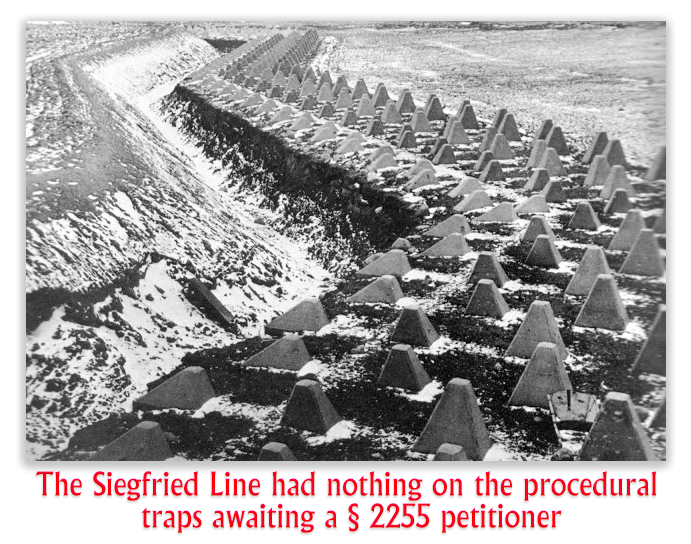We post news and comment on federal criminal justice issues, focused primarily on trial and post-conviction matters, legislative initiatives, and sentencing issues.

5th CIRCUIT DEALS TWO SETBACKS TO 2255 PROCEDURE
The 5th Circuit handed down a pair of 2255 procedural decisions last week that complicate matters for inmates seeking post-conviction relief in that circuit.
 Every inmate law library denizen knows that if the district court denies a 2255, the Federal Rules of Civil Procedure let the defendant file a motion to alter the judgment under Federal Rule of Civil Procedure 59(e). It seems like a free bite of the apple: you get to reargue your position, and a timely-filed 59(e) stops the clock running on the appeal deadline.
Every inmate law library denizen knows that if the district court denies a 2255, the Federal Rules of Civil Procedure let the defendant file a motion to alter the judgment under Federal Rule of Civil Procedure 59(e). It seems like a free bite of the apple: you get to reargue your position, and a timely-filed 59(e) stops the clock running on the appeal deadline.
But, it turns out, a 59(e) motion is not free of cost. Andre McDaniels found that out last week. After the district court denied his 2255, which was based on ineffectiveness of counsel, Andre filed a Rule 59(e) motion that argued the court had erred in refusing to grant an evidentiary hearing. That motion also was denied. Andre got a certificate of appealability from the 5th Circuit, but the government complained the Circuit lacked jurisdiction to hear the appeal.
The Supreme Court’s 2005 Gonzalez v. Crosby decision held that Rule 60(b) motions filed in 2255 cases seeking “to add a new ground for relief” or “attack the federal court’s previous resolution of a claim on the merits” is a second-or-successive 2255 petition. A motion that merely targets a procedural defect in the integrity of the federal habeas proceedings, however, remains a bona fide Rule 60 motion over which a district court has jurisdiction.
Circuit courts are applying Gonzalez to Rule 59 motions filed in 2255 the allegations that he had made in the 2255 motion, and complained the district court had erred in dismissing the motion without an evidentiary hearing. The 5th Circuit ruled that the district court lacked jurisdiction to hear Andre’s substantive claims under the 5th and 6th Amendments. Because they attacked the district court’s previous ruling on the merits, they constituted a successive habeas application.
However, his claim that the district court should have conducted an evidentiary hearing was not an attack on the decision on the merits, but rather on the proper procedure used by the district court in the 2255 proceeding. Andre was able to go forward on that issue.
In a separate decision, the 5th Circuit weighed in on a circuit split on the meaning of 28 USC 2244(d)(1)(D). That statute permits second-and-successive 2255 motions in some cases, including newly discovered evidence. The 5th Circuit held that to show there is newly-discovered evidence, a defendant must “establish that the affidavits were unavailable to trial counsel at the time of trial.” A number of other circuits hold only that the evidence must be “reliable evidence that was available but not presented at trial.”
 The Circuit ruled that movant Jamal Hancock failed to show his evidence was newly discovered, because “it was always within the reach of petitioner’s personal knowledge or reasonable investigation.” The Court admitted it had not previously “decided what affirmatively constitutes ‘new’ evidence,” but it has “explained what does not.” Jamal’s affidavits did not show the witness affidavits were unavailable to his attorney at the time of trial, and therefore the Court held that Jamal had offered no “new” evidence.
The Circuit ruled that movant Jamal Hancock failed to show his evidence was newly discovered, because “it was always within the reach of petitioner’s personal knowledge or reasonable investigation.” The Court admitted it had not previously “decided what affirmatively constitutes ‘new’ evidence,” but it has “explained what does not.” Jamal’s affidavits did not show the witness affidavits were unavailable to his attorney at the time of trial, and therefore the Court held that Jamal had offered no “new” evidence.
United States v. McDaniels, Case No. 16-20508 (5th Cir., Oct. 26, 2018)
United States v. Hancock, Case No. 16-20662 (5th Cir. Oct. 23, 2018)
– Thomas L. Root

